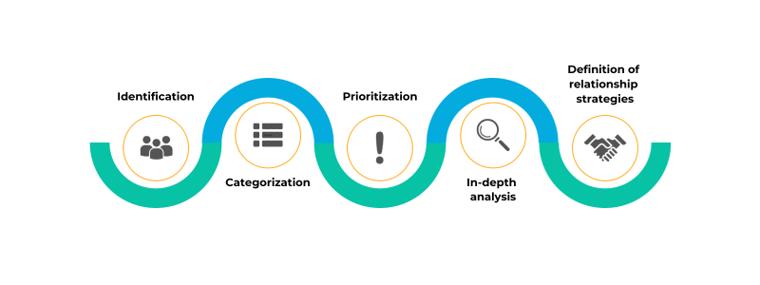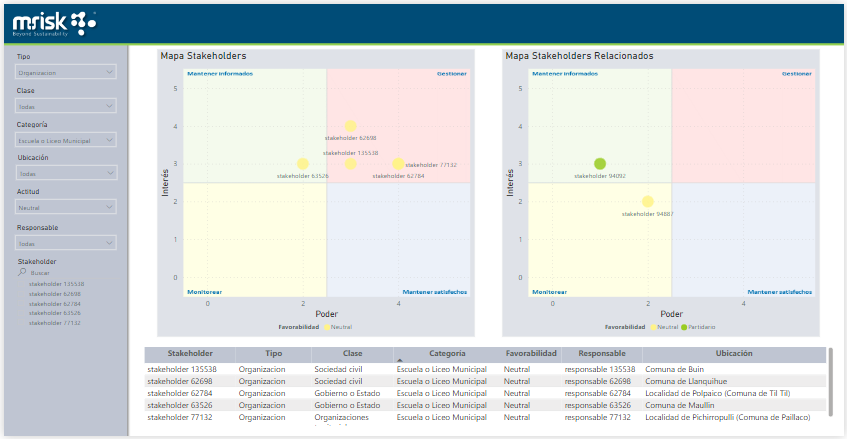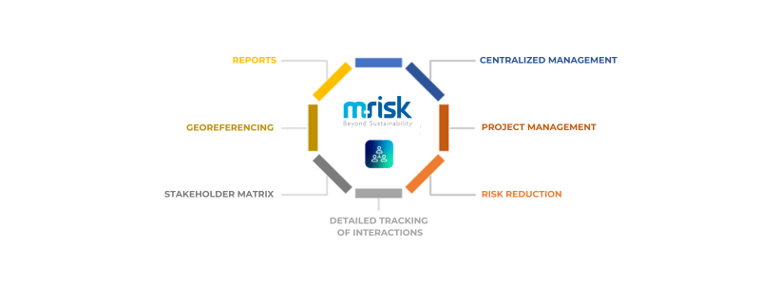Effective Stakeholder Management Strategies: Driving Corporate Sustainability with ESG Management Software

Today, it is unquestionable that "companies seeking sustainability in their activities must know their stakeholders, enhance dialogue, meet demands and expectations, and be transparent in the accountability of their actions." In today's environment, "being connected" with stakeholders is an essential requirement for maintaining a competitive advantage. In fact, the proper management of a company's stakeholders is an essential pillar to ensure its long-term sustainability.
It is a mistake to think that only shareholders have a say. There are other groups or individuals who influence and can determine the direction of an organization. Understanding the expectations and demands of these stakeholders and integrating them into corporate strategy is a powerful tool for socially responsible positioning.
In this article, we explain an effective methodology to manage your company's stakeholders through ESG management software.
Identification of Key Stakeholders
The first step in any stakeholder management strategy is to identify relevant stakeholders. These can include customers, suppliers, employees, and even shareholders and regulators.
It is, therefore, essential to map and analyze the relationship with these stakeholders in order to strengthen and consolidate relations. To do so, it is necessary to follow these steps:
- Identification: build a list of all possible stakeholders related to your organization.
- Categorization: classify them into different categories, which can be based on their level of influence, interest, or nature of your organization.
- Prioritization: assign them a level of importance for the organization. It is essential to determine which are the most relevant based on criteria such as their power of influence, level of interest in the organization, or the potential impact they can have on your operations.
- In-depth analysis: once prioritized, it is essential to understand in depth the needs, expectations, and concerns of key stakeholders.
- Definition of relationship strategies: based on the information gathered, define specific strategies to interact with each group or category of stakeholders.

Stakeholder Engagement
Having fulfilled the previous point, it is vital to establish a genuine commitment with them. Engagement is not simply an act of communication but a strategy that seeks to understand and value stakeholders at all levels of the organization in order to achieve effective communication and build strong relationships.
Communication with stakeholders must be transparent, bidirectional, and carried out on a regular basis; to build a solid relationship with them, it is necessary to be consistent and comply with promises and requirements, in addition to understanding the concerns and expectations of stakeholders. communicating at the same time the vision and mission of the organization.
It is worth remembering that "If a company is seen as responsible, then it gains more trust from its stakeholders, and ultimately improves its business.”
Benefits of Effective Stakeholder Management
Stakeholder management not only prevents conflicts but can also boost corporate sustainability and enhance reputation. By considering and acting on stakeholder concerns and needs, companies can better adapt to change and ensure sustainable growth.
The main benefits of this approach are:
- Conflict prevention: through dialogue and collaboration, it is possible to identify potential areas of friction before they escalate into real conflicts.
- Improved reputation: companies that are perceived as socially responsible, transparent, and committed to their stakeholders enjoy a better public image and customer preference, ultimately making them more attractive to investors.
- Adaptability and resilience: companies that actively listen to their stakeholders become more agile and better able to adapt to change.
- Corporate sustainability: stronger foundations are laid for long-term sustainable growth. This ensures that the company not only achieves economic benefits but also shows its consideration for social and environmental impacts.
- Strengthened relationships and loyalty: effective stakeholder management builds trust and creates lasting relationships, promoting greater loyalty.
Technology for Stakeholder Management
The digital era has revolutionized stakeholder management, and M-Risk's ESG management software is at the forefront of this transformation. This software solution offers a comprehensive application for stakeholder management, combining advanced features of centralized and structured information recording, interaction tracking and prioritization tools, and, of course, reporting and data analysis.
In addition, the distributed and collaborative work on the platform allows the construction of institutional memory with detailed information on historical interactions.
Using technological tools such as M-Risk facilitates adaptability and efficiency in the management of stakeholder relations, reducing errors and providing immediate access to vital information. In addition, this type of software fosters a collaborative environment where transparency and fluid communication are key, enabling decisions aligned with stakeholder interests.
Mapping and understanding the relationship with stakeholders is fundamental. Through M-Risk, companies can have a clear perspective of these groups, identifying who is most relevant and what concerns they have, facilitating the allocation of priorities and resources.
Some of the benefits of M-Risk software are:
- Automatic Reporting and Advanced Data Analysis: all preconfigured reports and special data analysis for key Stakeholder cases.
- Detailed Tracking: complete history of interactions with each of the identified Stakeholders.
- Stakeholder Matrix: a matrix that allows a specific analysis of each Stakeholder regarding their power and interest with respect to the organization.
- Georeferencing: the application allows georeferencing the Stakeholders, being able to obtain in one view the position of the organization (areas of operational influence) with respect to its Stakeholders.
- Centralized Management: all information is stored and managed centrally, unifying in the platform the relevant and priority issues to be managed.
- Project management: the functionality of the application allows you to manage as a project all the agreements with the Stakeholders, being able to assign responsibilities and keep track of budgets.
- Risk reduction: By having a unified basis, the lack of knowledge about agreements with stakeholders is minimized.
With M-Risk, organizations not only map and analyze their stakeholders but also strengthen ties and consolidate relationships, thus supporting their social responsibility. In this way, the software is a strategic ally, enabling proactive management focused on promoting corporate sustainability.

.png?width=1239&height=605&name=imagen%20(2).png)
.png?width=841&height=437&name=imagen%20(3).png)
![]()
Interested in transforming the way your company manages its stakeholders? Discover how our platform can be the ally you are looking for. Request a demo and start your journey to effective stakeholder management today.




